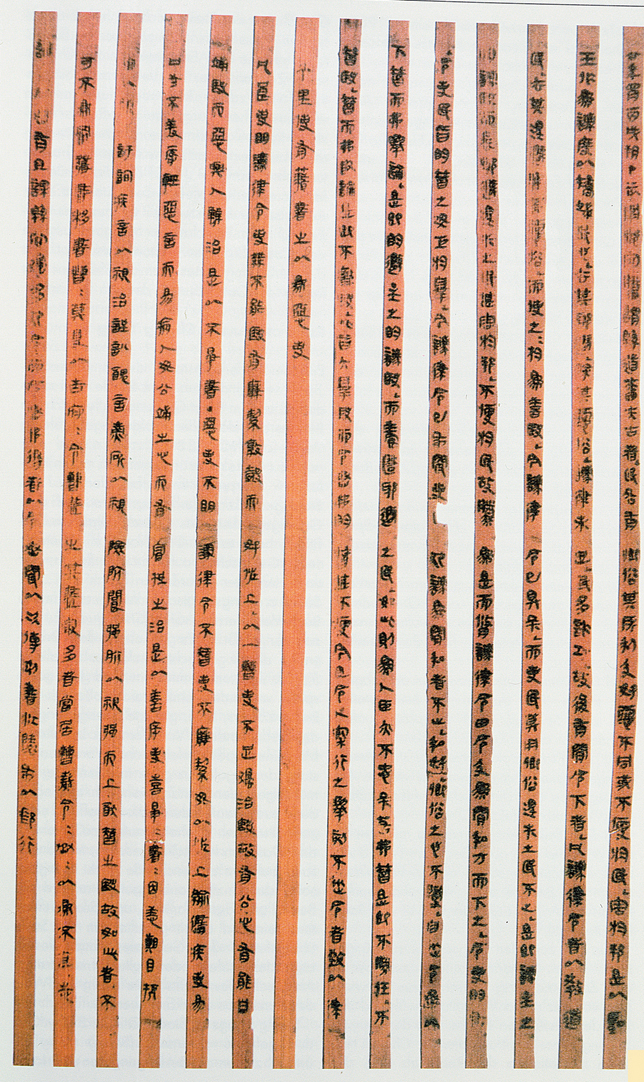Legalism
Over the course of the fourth and third centuries B.C.E., one small state after another was conquered, and the number of surviving states dwindled. Rulers fearful that their states might be next were ready to listen to political theorists who claimed expertise in the accumulation of power. These theorists, labeled Legalists because of their emphasis on the need for rigorous laws, argued that strong government depended not on the moral qualities of the ruler and his officials, as Confucians claimed, but on establishing effective laws and procedures. Legalism, though eventually discredited, laid the basis for China’s later bureaucratic government.

Picturing the PastInscribed Bamboo Slips In 1993 Chinese archaeologists discovered a late-fourth-century- B.C.E. tomb in Hubei province that contained 804 bamboo slips bearing some 12,000 Chinese characters. Scholars have been able to reconstruct more than a dozen books from them, many of them previously unknown. (Private Collection/Archives Charmet/The Bridgeman Art Library)ANALYZING THE IMAGE Can you spot any repeated characters? Can you see any very simple characters?CONNECTIONS What were the consequences of recording texts on bamboo or wooden strips? How might doing so have shaped reading and writing in Zhou times? For modern archaeologists who discover these texts in tombs, would the medium used pose any challenges?
In the fourth century B.C.E. the state of Qin radically reformed itself along Legalist lines. The king of Qin abolished the aristocracy. Social distinctions were to be based on military ranks determined by the objective criterion of the number of enemy heads cut off in battle. In place of the old fiefs, the Qin king created counties and appointed officials to govern them according to the laws he decreed at court. To increase the population, Qin recruited migrants from other states with offers of land and houses. To encourage farmers to work hard and improve their land, they were allowed to buy and sell it. Ordinary farmers were thus freed from serf-like obligations to the local nobility, but direct control by the state could be even more onerous. Taxes and labor service obligations were heavy. Travel required a permit, and vagrants could be forced into penal labor service. All families were grouped into mutual responsibility groups of five and ten families; whenever anyone in the group committed a crime, all the others were equally liable unless they reported it.
Legalism found its greatest exponent in Han Feizi (ca. 280–233 B.C.E.), who had studied with the Confucian master Xunzi but had little interest in Confucian values of goodness or ritual. In his writings he warned rulers of the political pitfalls awaiting them. They had to be careful where they placed their trust, for “when the ruler trusts someone, he falls under that person’s control.”14 This is true even of wives and concubines, who think of the interests of their sons. Given subordinates’ propensities to pursue their own selfish interests, the ruler should keep them ignorant of his intentions and control them by manipulating competition among them. Warmth, affection, or candor should have no place in his relationships with others.
Han Feizi saw the Confucian notion that government could be based on virtue as naive. Even parents, he argued, treat their sons and daughters differently based on their assessment of long-term advantage. That is, they celebrate when a son is born, because he will be able to continue the family, but are dejected when a daughter is born, since she will eventually leave. In Han Feizi’s view, it is unrealistic to expect people with no close kinship tie to treat each other more altruistically than parents treat their children. If rulers would make the laws and prohibitions clear and the rewards and punishments automatic, then the officials and common people would be easy to govern. Uniform laws get people to do things they would not otherwise be inclined to do, such as work hard and fight wars; such laws are thus essential to the goal of establishing hegemony over all the other states.
The laws of the Legalists were designed as much to constrain officials as to regulate the common people. The third-century- B.C.E. tomb of a Qin official has yielded statutes detailing the rules for keeping accounts, supervising subordinates, managing penal labor, conducting investigations, and many other responsibilities of officials. Infractions were generally punishable through the imposition of fines.
Legalism saw no value in intellectual debate or private opinion. Divergent views of right and wrong lead to weakness and disorder. The ruler should not allow others to undermine his laws by questioning them. In Legalism, there were no laws above or independent of the wishes of the rulers, no laws that might set limits on rulers’ actions in the way that natural or divine laws did in Greek thought (see Chapter 5).
Rulers of several states adopted some Legalist ideas, but only the state of Qin systematically followed them. The extraordinary but brief success Qin had with these policies is discussed in Chapter 7.
